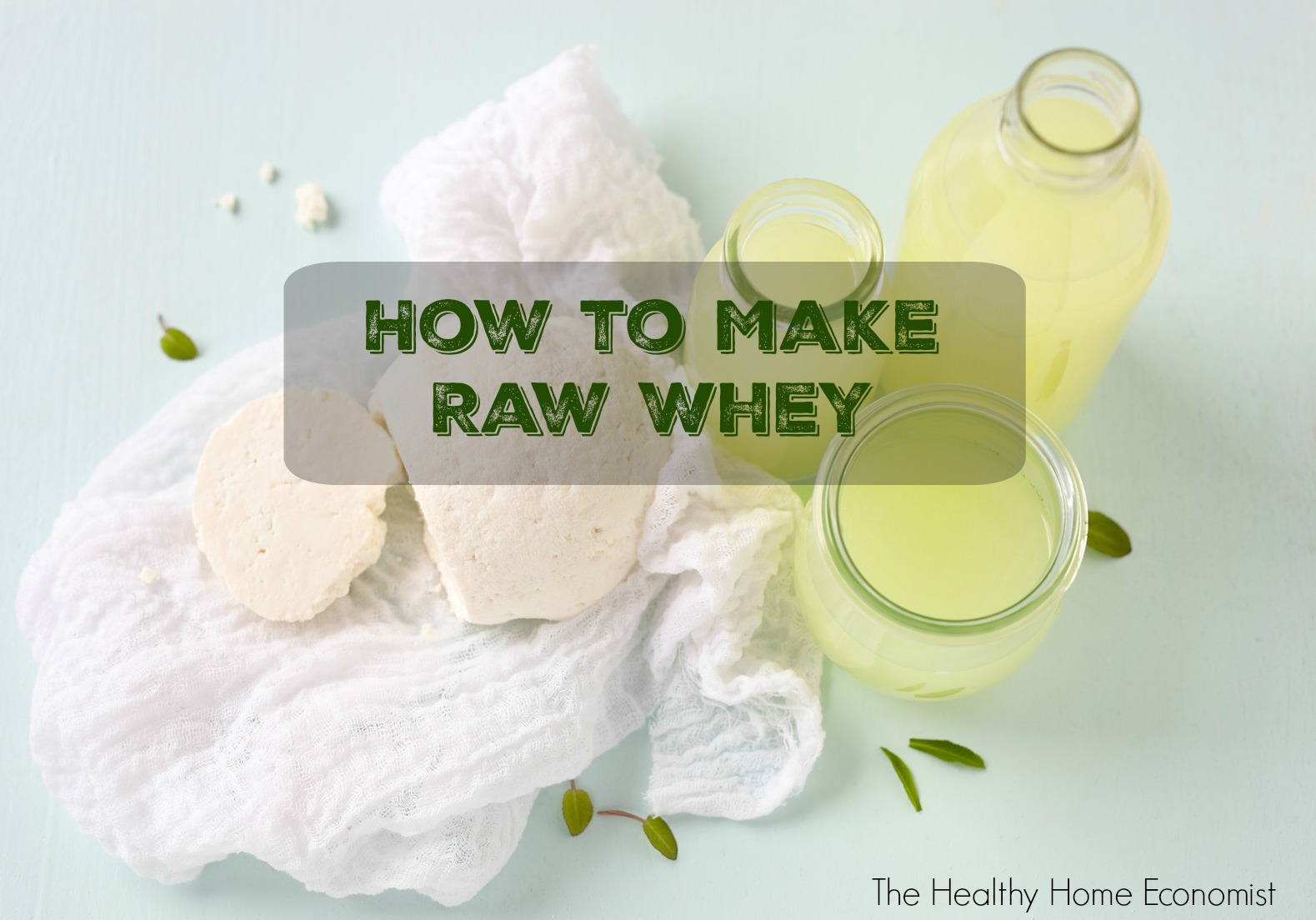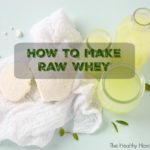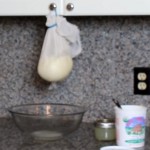How to make raw, enzyme and probiotic-rich liquid whey to use as a starter culture for all your home fermentation needs.

Do you know how to make whey from yogurt, kefir or raw milk?
A by-product of this simple technique is healthy homemade cream cheese that is loaded with enzymes and probiotics.
The recipe below describes how with visual instructions via video demonstration!
Making homemade baby formula? I recommend using this “quick whey” no straining method as the fastest and easiest approach.
How to Make Whey the REAL Way
Making real, liquid, nutrient rich, unadulterated whey in your own kitchen is a MUST step for any traditional cook to learn.
Without whey in its whole, liquid form, many other traditional recipes cannot even be attempted. You cannot buy whey from the store except in a denatured, unhealthy, powdered whey form. It is worth your time to learn what I show you in the video below.
Other video lessons on this blog show you how to use this whole food form of whey to make many delicious, healthful recipes for your family. Whey as made in the video demo below will keep up to 6 months in the refrigerator in a sealed mason jar.
If you absolutely have no access to farm fresh milk to make whole, unadulterated, enzyme rich whey, then you can use plain, organic yogurt brand from the store instead. Here are tips on how to spot the best yogurt brands.
The process is basically exactly the same thing as shown in the video.
You won’t get nearly as much whey using yogurt as clabbered, farm fresh milk, but at least you can get enough to get you started.
Wonderful Whey and REAL Cream Cheese
The raw, enzyme-rich cream cheese I make in the recipe video below is fantastic on a sprouted or sourdough bagel for breakfast. Don’t buy the Ezekiel sprouted muffins as they contain soy. This low-carb bagel recipe is another great one to try.
If you prefer to buy, these sourdough bagels are available for shipping freshly made to your door.
To make, just take your cream cheese left over from making liquid whey and add a few strawberries and a dash of dark maple syrup to taste. Mix together by pulsing a few times in your food processor. This wonderful, fresh, REAL strawberry cream cheese will last one to two weeks in the refrigerator. Another wonderful use for this healthy raw cheese is to make an easy no bake cheesecake.
No access to raw milk where you live? No problem. Check out this recipe plus video on how to separate whey from yogurt purchased from the store.
Cloudy Whey vs Clear Whey
No matter whether your whey turns out cloudy or clear, it is safe and fine to use in all your favorite recipes. This article explains why sometimes whey is cloudy compared to its usual golden color.

Raw Whey Recipe
How to separate raw, liquid whey from clabbered milk. The process also creates probiotic rich cream cheese.
Ingredients
- 1 quart raw milk preferably grassfed
- 1 large glass bowl
- 1 large rubber band
- 1 white dishtowel
Instructions
-
Allow the raw milk to sit on the counter for 1-3 days at room temperature.
-
When the milk separates into curds and whey (transforms into clabbered milk) you are ready to proceed. Note that the fresher the raw milk and the colder the temperature of your house, the longer it will take the raw milk to clabber.
-
Line a clean, large glass bowl with a clean, white dishtowel that isn’t too thick. Cheesecloth will also work, but the holes in the mesh must be very small, else the milk curds will pass through.
-
Gently pour the clabbered milk into the middle of the dish towel. Gather up the ends and fasten with a rubber band. Attach to a knob on an upper cabinet in your kitchen as shown in the picture.

-
Let the raw whey drip into the bowl underneath. This process will continue for an hour or two.
-
After the dripping stops, gently take down the hanging bag and place it into a clean bowl. Scrape out the raw cream cheese that is inside the bag, put in a container with a lid and refrigerate.
-
Pour the liquid whey from the dripping bowl into a glass mason jar, afix the lid and refrigerate.
-
Refrigerated, raw cream cheese will be good to eat for about a week. Raw whey will last several months refrigerated.
Recipe Video
How to Use Whey in Recipes
How to Make Ricotta Three Ways (plus Video How-to)
Perfect Probiotic Cottage Cheese
Cheese Making: Common Problems and Solutions








So I am pretty sure the whey turned out well, but the cheese not so much. I am not sure what I did wrong, or if in fact it was wrong and I just didn't like it.
I used fresh milk and left it on the counter for a little over 48 hours. It didn't look big and chunky like yours in the video but it had seperated and was thick.
It dripped for almost 5 hours and at 11:30p before heading to bed I put in the fridge, still hanging. Not sure when it stopped dripping.
Some of the cheese was kind of crusty and yellow. I just mixed it all togehter and it brought it back to a creamy texture.
It just tasted bad. Sour. Yucky.
Did putting it in the fridge mess it up? How long is it suppossed to drip for?
I’ve found that sometimes the taste of the cheese can be sour if the cheese hasn’t dripped adequately. You can do a couple of things. If the inside of your cloth has a thick layer around the outside but the inside is still quite liquid, you’re cheesecloth may literally be clogged. If you lay it in a colander or large strainer, you can scrape the dryer stuff off the outside and mix it back in, then let it hang again. Or you can find a more loosely woven muslin fabric. The more whey you get out of the process, the sweeter the cheese should be. The longer drip time should also produce a thicker cheese.
Also, even though we may not be able to detect it in the very fresh milk, if a cow or goat has eaten a different plant recently, it can especially affect the taste of the cheese. The plant may not be toxic, but sometimes at different times of the season, different plants bloom or grow better. The animals definitely like some better than others and sometimes just the change in their diet will affect flavor.
One other possible problem is if the cow was just starting to develop mastitis. If it was at a subclinical stage, the milk might taste okay for a day or two and then start to go bad quite quickly. It will definitely have an off flavor, especially in the cheese.
Hi Stephanie, that is a way lateral thought about clabbering the breastmilk! Wow! I have never even thought of doing this, but I don't see why it wouldn't work.
I just wrote a post yesterday about why clabbered raw milk is safe and pasteurized milk goes putrid and dangerous if you do the same thing. Here's the link:
https://www.thehealthyhomeeconomist.com/best-use-ever-for-soured-raw-milk
I kinda feel like I am stalking your site, but I just have so many questions!!
My husband wanted to know about the safety of leaving the milk out to clabber. He doesn't understand why its ok to eat sour milk and why its not "bad". I no other answer for him other than I trust Sarah and he said well, that's not good enough for him. He's an engineer and needs; facts! and data! and research! Can you give me a link to quiet him?
🙂
I just had a random thought! Can I do this with breastmilk and make cheese for my daughter to eat? She's nine months, so now cows milk yet for her.
If I could, do you think it would make a difference if it was breastmilk that was thawed and previously frozen?
I’d be really interested in whether this turned out – having breastfed 3 boys (10 years) I know, however, that breastmilk is extremely low in fat and high in protein, and I suspect that this would make it difficult – doesn’t the whole process depend on their being fat in the milk,
I am also wondering about making whey from breastmilk. I have a very sensitive 13 month old who has a milk protein intolerance. He I still breastfed and reacts when I have dairy of any form in my diet. I have yet to try adding it to his. I old love to make some cultured/fermented veggies for him (and myself) but do not want to risk using cow’a milk whey. I would love to know if you or anyone else has tried it using breastmilk. Please contact me at [email protected] if possible! 🙂 thank you!
I have milk clabbering on the counter now. Learned a new word with that one. So glad I watched your video before attempted to this, the pictures in the NT book are so different with the spoon,etc.
P.S. you crack me up with your comments about philly cream cheese from the store.
Sometimes 36 hours isn't long enough for the milk to clabber particularly if the milk is not yet soured and the house is a bit cool. Glad you are enjoying the videos Cathy!
We rarely have milk that has soured. We drink it all up and then go for more. We use raw milk is that what you are referring to when you say from the farm? I put a quart of milk in a gallon glass jar sidesways on the counter about 36 hours ago and the cream is separating from the milk and it just smells odd no clabbering!. Is this ok? Should I start over and just leave a quart of milk in the refrigerator until it sours naturally? I love your videos, thank you for taking the time to do them. Cathy
Hi Erika, the reason I put the carton on its side is to get the milk to clabber more quickly … there is more air touching more of the milk which is why this happens.
So glad you are finding the videos helpful!!
Hi Sarah,
I just clicked over from Kitchen Stewardship, and I am so, so thankful I did! Our family is only now (finally) starting to make some changes to eating "real" food, and it's a bit overwhelming (probably the reason that it has taken so long to make the switch!). However, your video is so helpful! I'm a very visual learner, and seeing how you do it (and how easy it actually is!) is a huge help to me!
It is also very helpful when you tell approximately how long things will last and the best way to store them, like you did in the video. Thank you so much for taking the time to share this! I am really excited to explore your blog and read your new posts!
Erika
ps…this is such a novice question, so forgive me, but why do you put the carton on its side (instead of leaving it right side up)?
Sounds like the milk slightly clabbered in the fridge. Yes, that would be cream cheese. You may want to clabber it so that the solids completely separate from the whey and then strain it.